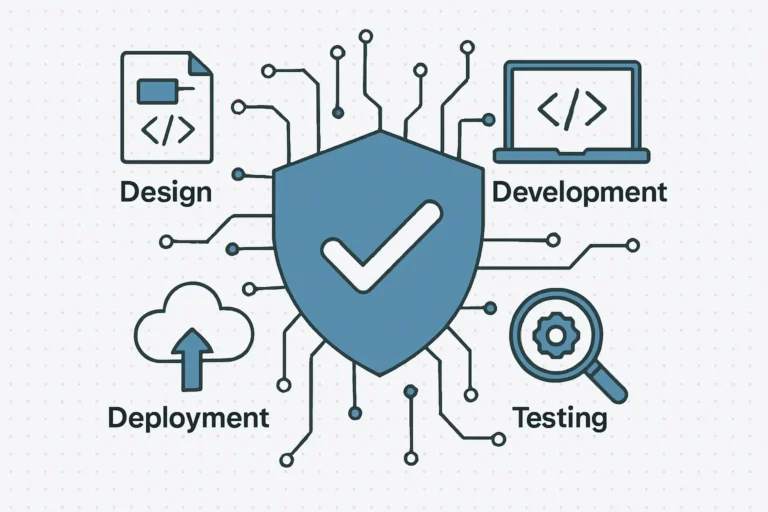
Understanding the Shift to DevSecOps
In the early days of software development, security was often seen as something to handle at the end. Developers would focus on building features, and security experts would step in just before release. This method may have worked in the past. However, today, with the increasing prevalence of cyber threats, it is no longer enough. Have you thought about DevSecOps in Software Development?
Modern development environments require security at every step. That’s why DevSecOps has emerged as a leading strategy. It stands for Development, Security, and Operations. This approach weaves security directly into the software development lifecycle, ensuring protection is not an afterthought but a built-in feature.
From DevOps to DevSecOps: A Necessary Evolution
DevOps changed the way teams build and deliver software. It brought development and operations together, allowing for faster and more reliable deployments. However, it left a gap. Security concerns were still treated as a separate issue.
That gap had to close as attacks became more complex and regulations became stricter. DevSecOps evolved to solve this. It extended the DevOps mindset to include security from the start. Instead of one team handling security at the end, now all teams share that responsibility from day one.
Embedding Security at Every Stage
The primary concept of DevSecOps is straightforward: security should be integrated throughout the entire development process. Security practices must be part of each phase, from planning and coding to testing and deployment. For example, developers run security scans as they write code. Testers check not just for bugs but also for vulnerabilities. Operations teams monitor for threats in real time.
This constant focus allows teams to catch problems early. Fixing a security flaw during development is much easier—and cheaper—than fixing it after a breach.
Automation and Continuous Monitoring
One of the greatest strengths of DevSecOps is its automation capabilities. Manual checks can be time-consuming and often miss issues. Automated tools can scan code, check configurations, and run compliance tests instantly. These tools become part of the continuous integration and deployment CD/CDs. That means every update, every commit, and every release includes a security check.
Additionally, DevSecOps emphasizes continuous monitoring. Once the software is live, systems continue to monitor for threats. Logs are analyzed, behavior is tracked, and alerts are raised at the first sign of trouble. This proactive approach enables teams to respond quickly, thereby reducing potential damage.
Building a Culture of Shared Responsibility
DevSecOps is not only about tools and processes. It’s about people. Traditionally, security was isolated to a single department. In DevSecOps, security becomes everyone’s job. Developers learn basic security principles. Operations staff understand how vulnerabilities can arise. Security professionals work side-by-side with the rest of the team.
This cultural shift enhances communication and yields better software. When everyone prioritizes security, applications are inherently safer.
How Pegotec Helps You Adopt DevSecOps
At Pegotec, we understand that security cannot wait. Our team helps organizations of all sizes integrate DevSecOps into their existing workflows. Whether you are building a new app or improving an existing one, we guide you through the transformation.
We start by analyzing your current processes. Then, we recommend the right tools to automate security checks. We also help you train your teams, ensuring everyone understands their role in securing software.
Furthermore, we tailor DevSecOps strategies to your needs. Not all businesses are the same, and not every tool is suitable for every case. Pegotec offers flexible solutions that match your size, industry, and goals.
From setting up secure CI/CD pipelines to integrating threat monitoring systems, Pegotec delivers complete DevSecOps support. With our help, you can release software faster, with fewer risks and full compliance.
The Benefits of DevSecOps in Software Development You Can Expect
Switching to DevSecOps with Pegotec brings clear advantages. You will see faster delivery of secure applications. You will also experience fewer security-related bugs, lower compliance risks, and more confidence in your software systems.
Moreover, by working with Pegotec, your teams gain knowledge. They become capable of maintaining and improving security independently. This long-term impact boosts your organization’s overall resilience and digital maturity.
The Future Is Secure by Design – DevSecOps in Software Development
DevSecOps is more than a trend. It is a necessary response to the digital threats facing businesses today. By integrating security into every stage of software development, companies create stronger products and safer user experiences.
As digital systems become increasingly complex, the need for integrated security will continue to grow. Now is the time to act.
At Pegotec, we help you take that step forward. Together, we build security into your development DNA. Contact Pegotec today to discuss The Evolution of DevSecOps: Integrating Security Into Every Development Stage.
Frequently Asked Questions About DevSecOps in Software Development
DevSecOps stands for Development, Security, and Operations. It integrates security practices into every stage of the software development lifecycle, ensuring protection is built in from the start.
DevOps focuses on collaboration between development and operations to deliver software quickly and reliably. DevSecOps adds security as a core component, making it a shared responsibility across all teams.
Cyber threats are more frequent and complex than ever. DevSecOps helps identify and fix security vulnerabilities early, reduces compliance risks, and ensures safer software releases.
Automation enables continuous security checks during development and deployment. Tools scan code, configurations, and dependencies to detect vulnerabilities instantly.
Continuous monitoring involves tracking applications and infrastructure in real time to detect threats, analyze logs, and trigger alerts before issues escalate.
In DevSecOps, security becomes a shared responsibility. Developers, operations staff, and security specialists work together to build and maintain secure systems.
Pegotec analyzes your workflows, recommends the right security tools, sets up secure CI/CD pipelines, trains your teams, and integrates monitoring systems to ensure security at every stage.
Need help with your project?
Book a free 30-minute consultation with our developers. No strings attached.